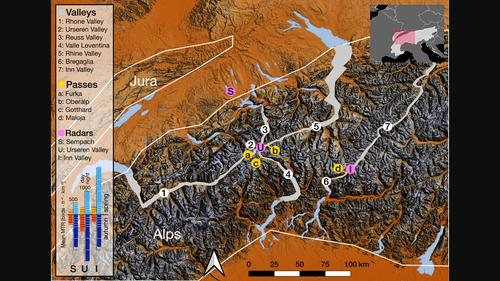当前位置:
X-MOL 学术
›
Remote Sens. Ecol. Conserv.
›
论文详情
Our official English website, www.x-mol.net, welcomes your feedback! (Note: you will need to create a separate account there.)
High-intensity bird migration along Alpine valleys calls for protective measures against anthropogenically induced avian mortality
Remote Sensing in Ecology and Conservation ( IF 5.5 ) Pub Date : 2024-01-04 , DOI: 10.1002/rse2.377 Simon Hirschhofer 1, 2 , Felix Liechti 2 , Peter Ranacher 1 , Robert Weibel 1 , Baptiste Schmid 2
Remote Sensing in Ecology and Conservation ( IF 5.5 ) Pub Date : 2024-01-04 , DOI: 10.1002/rse2.377 Simon Hirschhofer 1, 2 , Felix Liechti 2 , Peter Ranacher 1 , Robert Weibel 1 , Baptiste Schmid 2
Affiliation

|
The Alps are a natural barrier for avian broad-front migration in Central Europe. While most birds that approach the Alps are deflected and circumvent the mountains, some choose to make the crossing. Here, they are funnelled and channelled in valleys, leading to high bird densities. Many Alpine valleys are suitable locations for wind farms, potentially creating a conflict between wind energy production and bird conservation. Collisions can be reduced by temporarily shutting down wind turbines. This however requires timely coordination, either by locally monitoring migration intensity or by extrapolating and forecasting migratory fluxes from other sites. However, little is known about the timing and intensity of bird migration in valleys of the central Alps, especially during spring migration. This study presents a 2-year quantification of avian migration across the Alps. We collected terrestrial radar data at three sites: two located in Alpine valleys and one in the lowland, close to the northern foothills of the Alps. We found high migration traffic rates (MTR) during both migration seasons in the Alpine valleys, with outstanding numbers of migrants during the spring season. The strong alignment of the flight directions with the main orientation of alpine valleys highlights the importance of valleys and the connected passes in channelling migratory fluxes through the Alps. However, extrapolating migration intensities and forecasting peak migration events for inner Alpine sites is difficult, likely due to how migratory patterns and activity are influenced by the complexity of the local topography and the associated dynamic wind and weather conditions. Instead, we call for year-round on-site monitoring of migration intensities and strategies tailored to the local context to reduce the risk of bird strikes at wind turbines in the Alps.
中文翻译:

沿着高山山谷的高强度鸟类迁徙呼吁采取保护措施,防止人为导致的鸟类死亡
阿尔卑斯山是中欧鸟类大迁徙的天然屏障。虽然大多数接近阿尔卑斯山的鸟类都会偏转并绕过山脉,但有些鸟类选择穿越山脉。在这里,它们在山谷中形成漏斗和通道,导致鸟类密度很高。许多阿尔卑斯山谷都是风电场的合适地点,这可能会造成风能生产和鸟类保护之间的冲突。暂时关闭风力涡轮机可以减少碰撞。然而,这需要及时协调,要么通过当地监测迁徙强度,要么通过推断和预测来自其他地点的迁徙通量。然而,人们对阿尔卑斯山中部山谷鸟类迁徙的时间和强度知之甚少,尤其是在春季迁徙期间。这项研究对跨越阿尔卑斯山的鸟类迁徙进行了两年的量化。我们在三个地点收集了地面雷达数据:两个位于阿尔卑斯山谷,一个位于靠近阿尔卑斯山北麓的低地。我们发现阿尔卑斯山谷的两个迁徙季节的迁徙流量(MTR)都很高,其中春季的迁徙人数特别多。飞行方向与高山山谷的主要方向紧密一致,突显了山谷和相连通道在引导迁徙通量穿过阿尔卑斯山方面的重要性。然而,推断迁徙强度并预测阿尔卑斯山内部地点的迁徙高峰事件很困难,这可能是由于迁徙模式和活动受到当地地形复杂性以及相关的动态风和天气条件的影响。相反,我们呼吁对迁徙强度进行全年现场监测,并根据当地情况制定策略,以减少鸟击阿尔卑斯山风力涡轮机的风险。
更新日期:2024-01-04
中文翻译:

沿着高山山谷的高强度鸟类迁徙呼吁采取保护措施,防止人为导致的鸟类死亡
阿尔卑斯山是中欧鸟类大迁徙的天然屏障。虽然大多数接近阿尔卑斯山的鸟类都会偏转并绕过山脉,但有些鸟类选择穿越山脉。在这里,它们在山谷中形成漏斗和通道,导致鸟类密度很高。许多阿尔卑斯山谷都是风电场的合适地点,这可能会造成风能生产和鸟类保护之间的冲突。暂时关闭风力涡轮机可以减少碰撞。然而,这需要及时协调,要么通过当地监测迁徙强度,要么通过推断和预测来自其他地点的迁徙通量。然而,人们对阿尔卑斯山中部山谷鸟类迁徙的时间和强度知之甚少,尤其是在春季迁徙期间。这项研究对跨越阿尔卑斯山的鸟类迁徙进行了两年的量化。我们在三个地点收集了地面雷达数据:两个位于阿尔卑斯山谷,一个位于靠近阿尔卑斯山北麓的低地。我们发现阿尔卑斯山谷的两个迁徙季节的迁徙流量(MTR)都很高,其中春季的迁徙人数特别多。飞行方向与高山山谷的主要方向紧密一致,突显了山谷和相连通道在引导迁徙通量穿过阿尔卑斯山方面的重要性。然而,推断迁徙强度并预测阿尔卑斯山内部地点的迁徙高峰事件很困难,这可能是由于迁徙模式和活动受到当地地形复杂性以及相关的动态风和天气条件的影响。相反,我们呼吁对迁徙强度进行全年现场监测,并根据当地情况制定策略,以减少鸟击阿尔卑斯山风力涡轮机的风险。



























 京公网安备 11010802027423号
京公网安备 11010802027423号